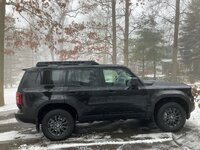In the 1980s, my uncle drove a 1969 MGB GT that he loved. He described it as quirky: burning oil, with erratic turn signals, and intermittently functional windows. But, he drove that car for years until his family got so large that he had to get a van. To this day, he describes it as his favorite vehicle.
After seven months and 10,000 miles, I wonder if I’m heading down a similar path with my LC 1958, or will I be driven mad by the litany of minor but annoying issues. Of the 10k miles I’ve driven, around 8k of those are local, and I’ve taken two trips of about 1k each. With respect to local driving, I’m about 70/30 highway/town with a decent amount of local driving light-duty off-road and snow. I’ve had the oil changed at 1k (reflecting comments on the board), 5k and 10k (scheduled service), and I averaged around 23.1 MPG in the warmer months, and 19.9 MPG in the colder. I have a pretty heavy foot. No mechanical issues to report.
Prior to the LC I had a 2019 4Runner Off Road (loved it), and prior to that I worked at GM, so I drove virtually everything in their lineup as a company car ranging from Bolt to Escalade. I can say without hesitation that the 1958 has exceeded my expectations in handling and performance in nearly every way, and I have to think back to my mom’s 1987 Toyota Camry for a vehicle that was more comfortable and as easy to drive.
I truly enjoy driving the car for short and long trips. Hence the 10k in seven months. The styling is also second to none, and I am a big fan of the utilitarian interior of the 1958. I considered the Lexus GX 550, but preferred the exterior styling of the LC, and had mechanical concerns given the main bearing problem.
With that having been said, here are quirks I’ve noticed with the 1958 (in no particular order, and non-exhaustive):
Features Thrown Together: The 1958 has a lot of features ranging from the very capable off-road system to a number of its other bells and whistles. That said, it seems like some of the items were either an after-thought or the interior design was finalized before the list of standard features was established. Example: the front window de-icer. On a normal car, or for 1958s sold in Canada apparently, there would be a de-icer button on the instrument panel. On the 1958, I have to navigate to it through the touch screen. Now that I know where it is, I can find it, and appreciate having the option, BUT it’s still a three-step process that should be one step.
Infotainment: Welcome to circa 2004. This is a known Toyota problem, but I’d almost prefer that the LC go 100% analog than include this half-hearted effort at an infotainment system. I can’t customize the ordering of the Toyota icons, and I am stuck seeing their advertisement for their subscription service every time I turn on the vehicle. It’s underwhelming to say the least, and it’s on my list of items that I expect will fail first. I wish I could replace the entire shit show with an after-market product along with the stereo and speakers.
Phone App Integration: When I purchased the 1958, Toyota provided the app connect service free for a period of time. While Toyota typically exceeds the US autos from a build quality perspective, they lag in all tech and particularly this tech. If I remote start my car, the App does not sync when I get in the vehicle. Also, the mileage is usually inconsistent between the vehicle and the app – off by 5 miles or less. It’s very sloppy and clunky, and effectively defeats the purpose of the App and makes it annoying and unreliable.
Driver Safety Aids: I’ve not yet determined whether Toyota’s safety features are meant to save you or kill you. The incessant binging and whining of the various items is beyond annoying and ultimately not helpful. I realize that you can customize the safety features to a degree, and have done so, but some you can’t turn off. AND, when you retain some that you’d like, such as various sensors, the second there is rain or a large snowflake, the system freaks out and you are limited in disabling the notifications. The system also very frequently reminds you, like every 60 seconds, when something is not working. Since around mid-January, most of the sensor-based systems on the vehicle have either self-disabled, or I’ve had to turn them off. Again, I’d prefer a very base analog approach rather than what Toyota has done.
Saved Settings Aren’t Permanently Saved: Toyota offers you the ability to save a number of settings on the vehicle. This is nice from a customization perspective. However, the system is inconsistent in saving the settings, and often forgets that they were saved so that you are required to change the settings periodically. Example: You can change the view of the instrument cluster. I have done so twice, and in doing so the changes were saved, but then several days later they reverted to the factory settings.
Aluminum Good and Bad: I believe the hood, and possibly the top of the vehicle are made of aluminum. While this is great from a vehicle weight perspective, having such a large flat surface made of aluminum rather than tempered steel has its drawbacks. I parked under an oak tree and ended up with a number of sizeable dents in my hood and roof as a result of falling acorns. 2012 Honda Odyssey and 2019 4Runner under same tree - no dents. That's on me, but something to be aware of.
First-Model-Year Issues. In buying the first model year of any vehicle, you know there will be some issues. In Toyota’s case, parts have been in short supply (e.g., windshields) but that didn’t really surprise me all that much. I will say that the Toyota techs don’t seem overly familiar with the LC systems. I have an idiot light on my dash (yellow circle with the vehicle in the middle), and when I took the car in for 10k service, the dealership wanted to keep the car for a day to run diagnostics - no idea what it meant. That was a little disappointing.
The Trunk: Two issues with the trunk: the stupid step up for the battery AND the lack of lighting. On the former point: really? Someone in design couldn’t have tackled this early in the process? On the lighting, there are two little spot lights on the side walls of the trunk, but how about a good old fashioned dome light or door light?
Seat Covers: I get that Toyota is attempting to “go green”, but I shouldn’t have to go to a third-party vendor to get actual leather seats. Granted, the Katzkin seats are well-made and comfortable, but some of us don’t want vinyl and leather should be a factory option. I’ve seen the Toyota/Lexus faux leather evolve over the years, but still prefer the real deal. Plus, the faux stuff is perforated, which allows mud to penetrate. This is strategic error on Toyota’s part, IMHO.
Seat Heating: Many threads on this forum on seat-heating issues. I had non-perforated vinyl seats on my Off-Road 4Runner, and they worked great. Those on the 1958: not so much. They work enough that I haven’t raised the issue with the dealer, but not what I would otherwise expect.
None of these is a major issue, but when taken together I’ll see over time whether they eventually drive me to get rid of the car, or I just accept them as mild quirks much like my uncle did in the 80s. The one difference between this car and the MGB GT is that this car, even in its base format, is around $60k all-in NEW. I just wonder if Toyota in its rush to put out this vehicle, its Lexus sibling, the 4Runner, and the other Toyota and Lexus products on the same frame architecture didn’t quite make the effort to fully bake the cake.
After seven months and 10,000 miles, I wonder if I’m heading down a similar path with my LC 1958, or will I be driven mad by the litany of minor but annoying issues. Of the 10k miles I’ve driven, around 8k of those are local, and I’ve taken two trips of about 1k each. With respect to local driving, I’m about 70/30 highway/town with a decent amount of local driving light-duty off-road and snow. I’ve had the oil changed at 1k (reflecting comments on the board), 5k and 10k (scheduled service), and I averaged around 23.1 MPG in the warmer months, and 19.9 MPG in the colder. I have a pretty heavy foot. No mechanical issues to report.
Prior to the LC I had a 2019 4Runner Off Road (loved it), and prior to that I worked at GM, so I drove virtually everything in their lineup as a company car ranging from Bolt to Escalade. I can say without hesitation that the 1958 has exceeded my expectations in handling and performance in nearly every way, and I have to think back to my mom’s 1987 Toyota Camry for a vehicle that was more comfortable and as easy to drive.
I truly enjoy driving the car for short and long trips. Hence the 10k in seven months. The styling is also second to none, and I am a big fan of the utilitarian interior of the 1958. I considered the Lexus GX 550, but preferred the exterior styling of the LC, and had mechanical concerns given the main bearing problem.
With that having been said, here are quirks I’ve noticed with the 1958 (in no particular order, and non-exhaustive):
Features Thrown Together: The 1958 has a lot of features ranging from the very capable off-road system to a number of its other bells and whistles. That said, it seems like some of the items were either an after-thought or the interior design was finalized before the list of standard features was established. Example: the front window de-icer. On a normal car, or for 1958s sold in Canada apparently, there would be a de-icer button on the instrument panel. On the 1958, I have to navigate to it through the touch screen. Now that I know where it is, I can find it, and appreciate having the option, BUT it’s still a three-step process that should be one step.
Infotainment: Welcome to circa 2004. This is a known Toyota problem, but I’d almost prefer that the LC go 100% analog than include this half-hearted effort at an infotainment system. I can’t customize the ordering of the Toyota icons, and I am stuck seeing their advertisement for their subscription service every time I turn on the vehicle. It’s underwhelming to say the least, and it’s on my list of items that I expect will fail first. I wish I could replace the entire shit show with an after-market product along with the stereo and speakers.
Phone App Integration: When I purchased the 1958, Toyota provided the app connect service free for a period of time. While Toyota typically exceeds the US autos from a build quality perspective, they lag in all tech and particularly this tech. If I remote start my car, the App does not sync when I get in the vehicle. Also, the mileage is usually inconsistent between the vehicle and the app – off by 5 miles or less. It’s very sloppy and clunky, and effectively defeats the purpose of the App and makes it annoying and unreliable.
Driver Safety Aids: I’ve not yet determined whether Toyota’s safety features are meant to save you or kill you. The incessant binging and whining of the various items is beyond annoying and ultimately not helpful. I realize that you can customize the safety features to a degree, and have done so, but some you can’t turn off. AND, when you retain some that you’d like, such as various sensors, the second there is rain or a large snowflake, the system freaks out and you are limited in disabling the notifications. The system also very frequently reminds you, like every 60 seconds, when something is not working. Since around mid-January, most of the sensor-based systems on the vehicle have either self-disabled, or I’ve had to turn them off. Again, I’d prefer a very base analog approach rather than what Toyota has done.
Saved Settings Aren’t Permanently Saved: Toyota offers you the ability to save a number of settings on the vehicle. This is nice from a customization perspective. However, the system is inconsistent in saving the settings, and often forgets that they were saved so that you are required to change the settings periodically. Example: You can change the view of the instrument cluster. I have done so twice, and in doing so the changes were saved, but then several days later they reverted to the factory settings.
Aluminum Good and Bad: I believe the hood, and possibly the top of the vehicle are made of aluminum. While this is great from a vehicle weight perspective, having such a large flat surface made of aluminum rather than tempered steel has its drawbacks. I parked under an oak tree and ended up with a number of sizeable dents in my hood and roof as a result of falling acorns. 2012 Honda Odyssey and 2019 4Runner under same tree - no dents. That's on me, but something to be aware of.
First-Model-Year Issues. In buying the first model year of any vehicle, you know there will be some issues. In Toyota’s case, parts have been in short supply (e.g., windshields) but that didn’t really surprise me all that much. I will say that the Toyota techs don’t seem overly familiar with the LC systems. I have an idiot light on my dash (yellow circle with the vehicle in the middle), and when I took the car in for 10k service, the dealership wanted to keep the car for a day to run diagnostics - no idea what it meant. That was a little disappointing.
The Trunk: Two issues with the trunk: the stupid step up for the battery AND the lack of lighting. On the former point: really? Someone in design couldn’t have tackled this early in the process? On the lighting, there are two little spot lights on the side walls of the trunk, but how about a good old fashioned dome light or door light?
Seat Covers: I get that Toyota is attempting to “go green”, but I shouldn’t have to go to a third-party vendor to get actual leather seats. Granted, the Katzkin seats are well-made and comfortable, but some of us don’t want vinyl and leather should be a factory option. I’ve seen the Toyota/Lexus faux leather evolve over the years, but still prefer the real deal. Plus, the faux stuff is perforated, which allows mud to penetrate. This is strategic error on Toyota’s part, IMHO.
Seat Heating: Many threads on this forum on seat-heating issues. I had non-perforated vinyl seats on my Off-Road 4Runner, and they worked great. Those on the 1958: not so much. They work enough that I haven’t raised the issue with the dealer, but not what I would otherwise expect.
None of these is a major issue, but when taken together I’ll see over time whether they eventually drive me to get rid of the car, or I just accept them as mild quirks much like my uncle did in the 80s. The one difference between this car and the MGB GT is that this car, even in its base format, is around $60k all-in NEW. I just wonder if Toyota in its rush to put out this vehicle, its Lexus sibling, the 4Runner, and the other Toyota and Lexus products on the same frame architecture didn’t quite make the effort to fully bake the cake.



